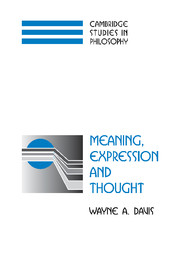Book contents
- Frontmatter
- Contents
- Preface
- 1 Introduction
- Part One Semantic Acts and Intentions
- Part Two Languages and Semantic Acts
- Part Three Thoughts and Ideas
- 12 Thought
- 13 Sentences, Propositions, and Thoughts
- 14 The Constituency Thesis
- 15 Ideas or Concepts
- 16 The Possession of Concepts
- 17 The Acquisition of Concepts
- 18 The Association of Ideas
- 19 Objects, Images, and Conceptions
- 20 The Language of Thought Hypothesis
- Part Four Ideational Theories of Meaning
- References
- Index
20 - The Language of Thought Hypothesis
Published online by Cambridge University Press: 20 July 2009
- Frontmatter
- Contents
- Preface
- 1 Introduction
- Part One Semantic Acts and Intentions
- Part Two Languages and Semantic Acts
- Part Three Thoughts and Ideas
- 12 Thought
- 13 Sentences, Propositions, and Thoughts
- 14 The Constituency Thesis
- 15 Ideas or Concepts
- 16 The Possession of Concepts
- 17 The Acquisition of Concepts
- 18 The Association of Ideas
- 19 Objects, Images, and Conceptions
- 20 The Language of Thought Hypothesis
- Part Four Ideational Theories of Meaning
- References
- Index
Summary
In §13.1, we said that thoughts are like sentences in being attitudinally neutral, abstract, generatively constructed representations with truth values and sentencelike constituent structures. The analogy between sentences and thoughts has led Fodor (1975) and others to speak of mental representation as a “language,” and to speak of the “language of thought.”
I believe that the language of thought idea is valuable for two reasons: it takes mental representations seriously, and it stresses their syntactic character. It emphasizes that mental representations have constituent structure. As a metaphor, the notion is unobjectionable, even apt. By providing a useful model of mental representation, the language of thought hypothesis serves to demystify the notion of thought, and to suggest ways to study and describe it. But when treated literally, as a serious hypothesis about what mental representations are, the view is misguided. Partly as a consequence, perhaps, there is a considerable lack of clarity in Fodor and others as to how thoughts are supposed to be related to the hypothesized formulas in the language of thought. Are its formulas the thoughts themselves, or “vehicles” that thinkers use in thinking? In this chapter, I will briefly survey the principal forms of the language of thought hypothesis that stretch the sentential analogy too far, and show why they are mistaken.
We will not be concerned with three things that might well be called “language of thought” hypotheses.
Information
- Type
- Chapter
- Information
- Meaning, Expression and Thought , pp. 519 - 550Publisher: Cambridge University PressPrint publication year: 2002
